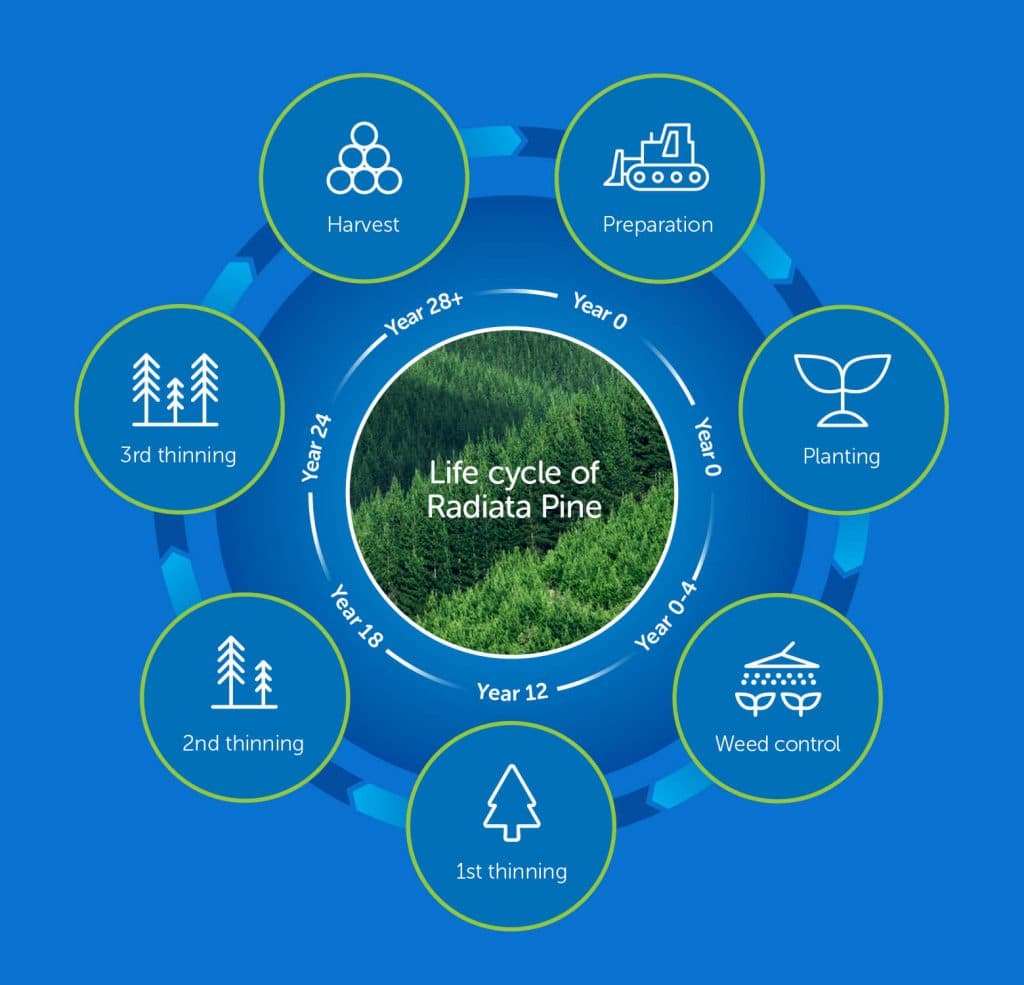Producing perfect timber … much more involved than you might think!
04 Mar 20
Timber is a versatile, natural fibre and is all around us in our houses, furniture and gardens, among many other things.
A huge amount of work goes into growing the best pine tree … and OneFortyOne takes great pride in delivering a quality timber source to Australians. Here’s what’s involved in the life cycle of a pine tree …

Before planting
The perfect pine starts with the perfect seedling or cutting. But what do we consider to be the perfect pine?
Our best performing trees are selected for a number of different characteristics to help produce high-quality timber. The first is volume — how much timber we can get out of the tree, its sweep — or how ‘bendy’ the tree is, branch size — the smaller the branch, the better the log, and the fourth is wood density. Denser wood produces high-quality timber. We select seed from parents that show these characteristics, grow these until the trees are old enough to reproduce and then ‘cross’ these under controlled conditions.
Therefore, our best performing pine trees grow lots of volume, is straight, with small branches and high-density wood.
OneFortyOne operates a tree nursery at Glencoe, South Australia, producing more than five million pine plants each year – a mix of seedlings and cuttings. OneFortyOne takes cuttings from the best trees in certain areas to match seedlings to both terrain and climatic conditions. In New Zealand, OneFortyOne contracts its nursery operations to a private company.
In Australia, ground is prepared for planting using a ‘chopper roller’ machine, which integrates the debris from logging back into the soil, helping it to break down and keeping the organic matter in the soil. A small patch is cleared using a scarifying machine ready for trees to be planted. In NZ, because of the steeper terrain limiting machine access, only areas on moderate slopes where there is a large amount of debris are cleared for the trees to be planted.
Planting
OneFortyOne plants about 3.5 million new trees in Australia and 1.8 million new trees in NZ each year. A tree will be between eight and 14 months old by the time it is planted.
Every area harvested is replanted ensuring there is a growing supply of timber for the future.
The trees are planted by hand at a density of 1600 stems per hectare in Australia and 800 stems per hectare in NZ. The difference in the planting densities is because of NZ’s steeper terrain. The steep slopes make it too difficult to commercially ‘thin’ the trees as they get older – more on this later.
The trees are densely planted so they grow straight and tall. Competition between trees at a young age also minimises the amount of weaker wood, which is not preferred for sawmilling and keeps the branches small.
Planting in both Australia and NZ takes place between June and September. This coincides with winter so the young trees get plenty of moisture to help them establish.
Early life
Trees are carefully managed during their early years to ensure they have enough nutrition and to keep weeds, pests and diseases under control.
Weeds and other vegetation compete with the young trees for nutrients and light so it is important they are controlled for the tree to establish and grow efficiently.
One of the main pests of concern for a growing tree is the syrex wasp. These wasps kill healthy pine trees by introducing a wood-rotting fungus and toxic mucus into the tree. OneFortyOne conducts an annual program to monitor for this pest. The wasp is controlled by introducing a nematode – a colourless, microscopic worm-like insect – into the trees which sterilises the female wasps.
Nutrition is another important consideration for growing trees. Nitrogen, phosphorus and potassium help to give the trees the best start and boost early growth, while boron in the form of a crushed rock Ulexite is spread over the young growing trees in NZ due to an underlying soil imbalance.
Thinning
Thinning is where some trees are harvested so the remaining trees have room to grow larger and stronger. Trees are fertilised with each thinning to help boost growth.
In Australia, once a plantation reaches 12 years, it is time for its first thinning. About 800 trees per hectare are removed in the first thinning — half of what was initially planted. The second thinning happens six years later when the trees are 18 years. Another 300 trees per hectare are removed in this phase, leaving 500 trees per hectare. After another six years, the third thinning occurs. This removes a further 175 trees per hectare, leaving 325 trees remaining for the final harvest.
At each thinning, trees removed are a bit larger and more valuable. At the first thinning, logs are small and used for production of small sawlogs, posts, woodchips and export log. By the second thinning, logs are a bit larger and can be used for these purposes, as well as small sawlogs, and for medium sawlogs by the third thinning.
A different approach is taken in NZ where steep slopes make it expensive to harvest young small trees while leaving other trees to grow bigger. When a young plantation reaches eight years, a third of the trees are removed. These trees are very small and are left on the ground to decay. This process is called thinning to waste.
Clearfell
The final harvest of the trees is called a clearfell. In NZ, this takes place when the trees are 26-28 years and in Australia when the trees are 32 years.
OneFortyOne clearfell harvests approximately 2200 hectares per year in both Australia and NZ. This produces high-value small, medium and large sawlogs.
Harvesting methods differ between Australia and NZ due to the topography of the plantations.
OneFortyOne’s Australian plantations are very flat, allowing easy access to forests for ground-based mechanical harvesting equipment. This enables ‘cut to length’ harvesting which involves one machine to fell, de-limb, measure and cut the logs accordingly, laying them out for collection by a forwarder which then transports the logs to the roadside. Here, they are loaded to trucks and transported to the local sawmill and other processors.
Because of the steep slopes where trees grow in NZ, mostly cable harvesting systems are
used. This process involves setting up a tower machine at the top of a hill with a cable running from the tower down the hill where it is fixed to a solid object – usually excavator or bull dozer – at the bottom. In this system, trees are mechanically felled on the slope and then fixed to the cable, which pulls the logs up to a clearing on top of the hill. Here, they are cut into different sorts, loaded onto trucks and transported to the local sawmill and other processors.
Processing
OFO has its own processing facilities in Australia and New Zealand that take some of the logs it produces. It also sells logs to local customers who produce a variety of products.
A number of different log grades come from a forest. Low quality logs are used in the manufacture of particle board or processed at a pulp mill to produce paper.
The next grade up is an industrial log. These logs are used in the manufacture of sawn timber for outdoor or landscaping applications, such as pine sleepers or garden edging. They are also used to make packing pallets and fence palings.
The highest quality logs are used to produce structural timber used in construction and in the case of NZ, timber is also used to make high-quality furniture.
OneFortyOne’s Australian mill is located in Mount Gambier, South Australia. The Jubilee Mill has a capacity of 800,000 cubic metres of logs per year. OneFortyOne’s NZ mill is located at Kaituna and has a capacity of 110,000 cubic metres of logs per year. The Jubilee Mill produces mainly structural timber used in the construction of houses and other buildings, while Kaituna produces mainly high-quality structural appearance grade timber for outdoor and landscaping uses, including the Australian market.
Wood chips from the sawing process at Jubilee are exported from the Port of Portland, while chips from Kaituna are sold to a local medium density fibreboard (MDF) manufacturer. Sawdust and waste wood are fully utilised at both mills to run boilers which produce heat for drying lumber
Celebrating timber
OneFortyOne is looking forward to celebrating International Day of Forests on Saturday, 21 March. It coincides with World Wood Day on the same date … keep an eye on our social media platforms for more news and updates.
News & Resources

23 Jun 25
News

21 May 25
Community
Continued partnership to support restoration and biodiversity projects

15 May 25
News

14 May 25
Our Stories
Honoring Boandik Country: OneFortyOne’s new artwork by Bonnie Saunders-Waye
OneFortyOne acknowledges the Traditional Custodians of Country throughout Australia and their deep connections to land, water, and community. We pay our respect to Elders past and present and extend that respect to all First Nations people today.
In Aotearoa New Zealand, Māori communities have a strong spiritual connection between people and the land – the wellbeing of one sustains the wellbeing of the other. We strive to build meaningful relationships with iwi as tangata whenua (people of the land/region), to be responsible intergenerational kaitiaki (stewards/guardians) of the land where our forests grow.

